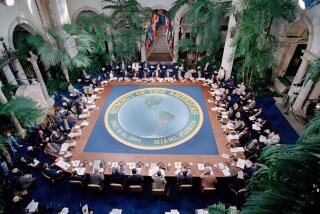The Pacific Rim: More Romance Than Reality
- Share via
Few people came to Long Beach last week for the first Pacific Rim Expo, which may also have been the last.
“It’s dead,” said a representative from a participating company on the fourth and final day of the event.
It is chic to be a Pacific Rimmer. If you are a Californian, especially in business consulting where client-building is important, it’s fashionable to talk up the rim. When Ronald Reagan reached the White House, he even named a Pacific Basin ambassador, the first. It was not whimsy.
About half of the world’s goods and services come from nations rimming the Pacific Ocean; the United States and Japan have the world’s two largest economies. More U.S. trade flows across the Pacific than the Atlantic, the case since 1977.
So it makes sense to have somebody looking after the Pacific Basin, and Ambassador Richard Fairbanks does an important job traveling the territory, giving speeches and keeping an ear open. But he may not be a true Pacific Rimmer, since he is skeptical of boosters who talk of a Pacific common market or any other kind of association with political undertones.
A typical Pacific Rimmer takes the economic megafacts about the United States, Japan, China, South Korea, Taiwan and the others, stuffs them into a pipe bowl and blows a colossal bubble encasing them all. The shimmering result is labeled Pacific Rim (or Pacific Basin, among other names) and presented as the world’s most lucrative, promising market.
It is illusion, of course. More divides the nations of the Pacific Basin than unites them. But for many West Europeans, the illusion creates anxiety. The French in particular seem to fear being shut out. And the Russians, who are suspicious of any grouping they cannot dominate, denounce the Pacific Basin as a Washington-Tokyo-Canberra conspiracy.
In fact, the Pacific Basin is a vague concept, except perhaps to an oceanographer. Stretching from the Arctic to the Antarctic, it is not and will not in our time be a common market, free-trade association or even a GATT (General Agreement on Tariffs and Trade) grouping or an Organization for Economic Cooperation and Development.
What it turns out to be is a matrix for massive trade flows--about $140 billion last year--and growing capital movement. These phenomena naturally follow industrial and technological development in the United States, Japan and, to a much lesser extent, some other Pacific countries. To make more of it is to raise false expectations, or fears.
The Pacific Basin doesn’t even have a traffic cop--no authority coordinates the movement of trade. And no collection of nations could have more disparity than the large and small, capitalist and socialist and communist, religious and non-sectarian, lending and borrowing, strong and weak countries of the basin.
It is half the world, and the only common link is a shoreline washed by the Pacific Ocean.
Even the free-market nations do not coalesce. Singapore would feel overwhelmed in the same league with the United States and Japan. (“At some point we might think of a Pacific Crescent,” a Singapore economic official said. “This would swing along the Asian coast from Japan to Australia, but preclude the United States.”) South Korea and Taiwan compete, and both, along with Japan, fear rising protectionism in the United States. Malaysia, Indonesia and Thailand are beginning to bite into some of South Korea’s and Taiwan’s old markets.
Yet the glint shines among Pacific Rimmers. Seminars and conferences on the Pacific Basin are held by the score each year, often sponsored by scholars but attended by government officials and business executives. UCLA has a Pacific Basin Law Review. USC holds Pacific Rim management programs. In Santa Barbara, the Pacific Basin Institute collects data. A U.S. Committee for Pacific Economic Cooperation has been formed.
Among the subjects Pacific Rimmers discuss when they get together is who should belong to the group. If China, what about Taiwan? What role for Vietnam and North Korea? How about Mexico and other Latin American countries? They also discuss agendas--what they should discuss. Topics range from nuclear energy to student exchanges.
An interdependent Pacific Basin, united in prosperity, might be the key to a secure and peaceful world. But it is rare to find even two countries with enough in common for a lasting bond. In the end, national interests prevail. As for year’s Pacific Rim Expo, it probably won’t attract as many as the 250 exhibitors who came this year. “We have better things to do than talk with other exhibitors,” one company’s representative said at her lonely booth.
More to Read
Sign up for Essential California
The most important California stories and recommendations in your inbox every morning.
You may occasionally receive promotional content from the Los Angeles Times.













